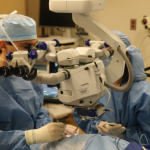Sports-related eye injuries can happen in the blink of an eye — and account for more than 30,000 emergency room visits each year. The good news? About 90 percent of these injuries can be prevented by wearing sports safety glasses.
Tomasz P. Stryjewski, M.D., Chief Resident and Director of the Eye Trauma Service at Mass. Eye and Ear, has seen eye injuries from just about every sport. Most are from sports that involve high-speed balls — like tennis, golf, baseball, lacrosse and hockey — or from air guns, like BB guns and paintball guns.
But even non-contact sports, like fishing, can pose a risk to unprotected eyes.
“When something hits the eye at high speeds, or with a lot of force, it can cause serious damage to both the eye and surrounding bones,” Dr. Stryjewski says. “And what people often don’t realize is that a major eye injury puts you at higher risk for lifelong problems, such as glaucoma.”
Protection with safety glasses is the best defense against these eye injuries. Before you hit the store, Dr. Stryjewski has some tips on how to choose the right gear.
1) Full coverage
We know what you may be thinking… Won’t regular prescription eye glasses or sunglasses provide some protection?
Not enough for most sports. For one thing, they’re not very strong. The lenses and frames could easily break during an intense contact sport like hockey or football. They also don’t cover the eyes completely. A stray ball or fishing lure could easily sneak through an opening in the frames.
Look for sports safety glasses with side shields and a wrap-around style.
2) Choose polycarbonate lenses
 Most sports goggles, helmets and face shields have polycarbonate lenses. This lightweight and shatterproof material provides the highest level of impact protection.
Most sports goggles, helmets and face shields have polycarbonate lenses. This lightweight and shatterproof material provides the highest level of impact protection.
It also protects the eyes from the sun’s rays, which is ideal for outdoor sports. And they are available in prescriptions.
3) Look for protection that is ASTM approved
Safety glasses that meet the American Society of Testing and Materials (ASTM) standards have been tested to ensure it provides the best level of protection.
4) Choose the frame that matches your sport
Different sports require different types of protection. ASTM International publishes requirements for many sports. You can also find guidelines online by searching the governing bodies for your specific sport.
For example, hockey players should wear full face guards with protective eye shields attached to their helmets, while racquetball and squash players should wear sports goggles with polycarbonate lenses.
5) Personalized fitting
If you wear eyeglasses on a daily basis, your eye doctor can help you pick out the proper frame and prescription lenses for your sports safety glasses. He/she can also make sure that the goggles fit correctly, which is important for both comfort and safety.
Customized fitting is especially important in children, because they are still growing. Remember to check the fit each year to ensure the googles still provide proper protection.
What should you do if you get hurt?
We hope these tips will help you find the right safety glasses to protect your eyes. But even with protection, injuries to the eyes can occur.
If you have a black eye, pain or visual disturbance for more than 10 minutes, call your eye doctor or go to the closest emergency room right away.
It’s hard to know how serious the injury is just by looking at the eye. At the Mass. Eye and Ear Emergency Department, which is open 24/7, ophthalmologists can examine the eye under a microscope to assess for eye injuries.
Here’s what to do until you can see a doctor:
- Cover the eye with a protective hard shield from a first aid kit. You can also make your own shield by taping a small paper cup over the eye. The goal is to not apply any pressure against the eye.
- Gently apply a cold compress if you’ve received a blow to the eye. But again, do not apply any pressure.
- Do not remove any objects that are stuck in the eye.
- Do not touch or rub the eye. Doing so could cause more damage.
- Do not apply ointments or medications unless directed by a doctor.
About Our Expert
Tomasz P. Stryjewski, M.D., is Chief Resident and Director of the Eye Trauma Service at Mass. Eye and Ear.
For more quick tips, see last year’s Q&A with Dr. Seanna Grob on sports eye injuries.





Great Article!! Are theses available in Baton Rouge, LA? I have great nephew’s and nieces in sports.
Thanks, Michael! Your best bet is to check in with a local optometrist or eye doc.